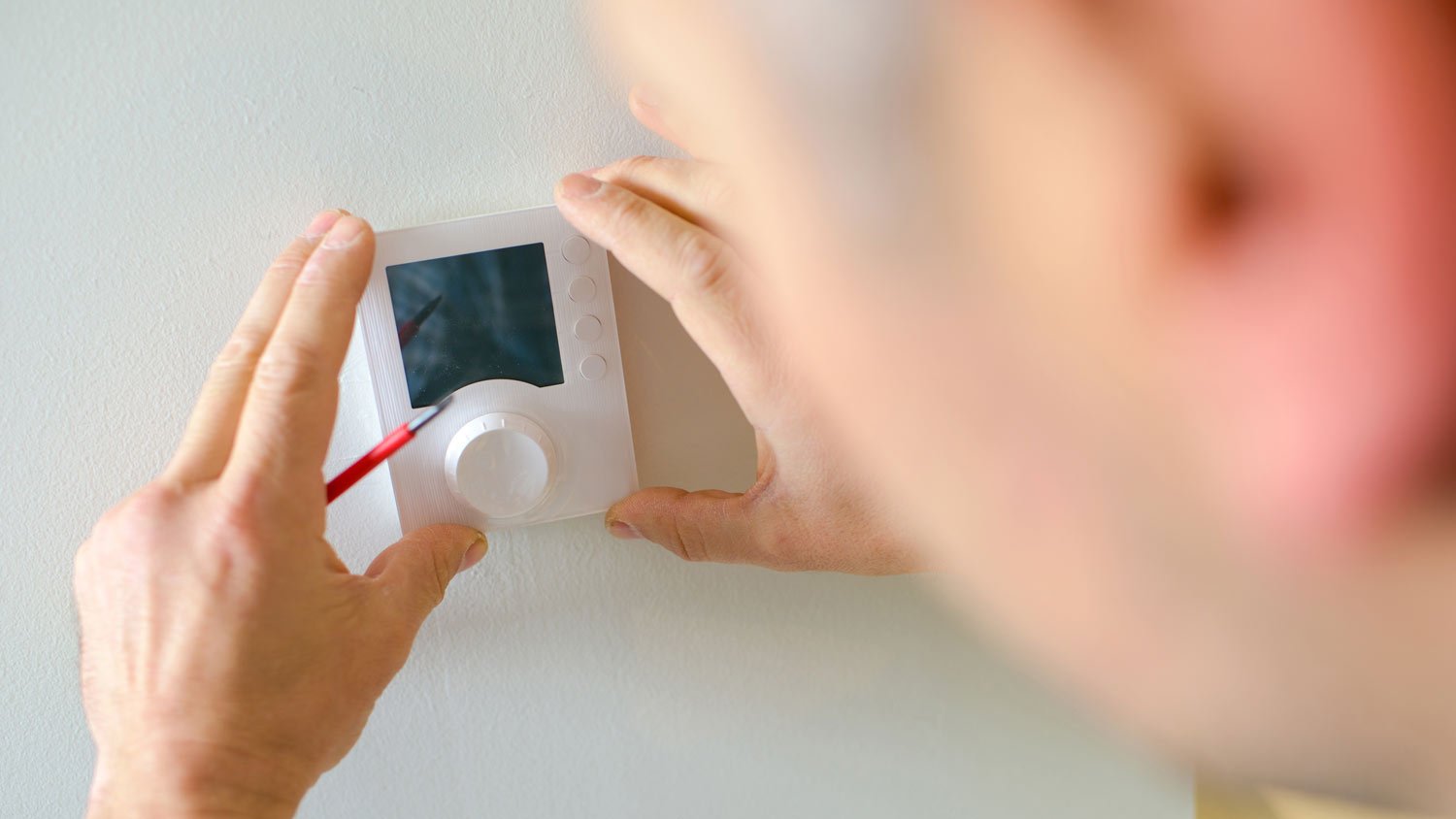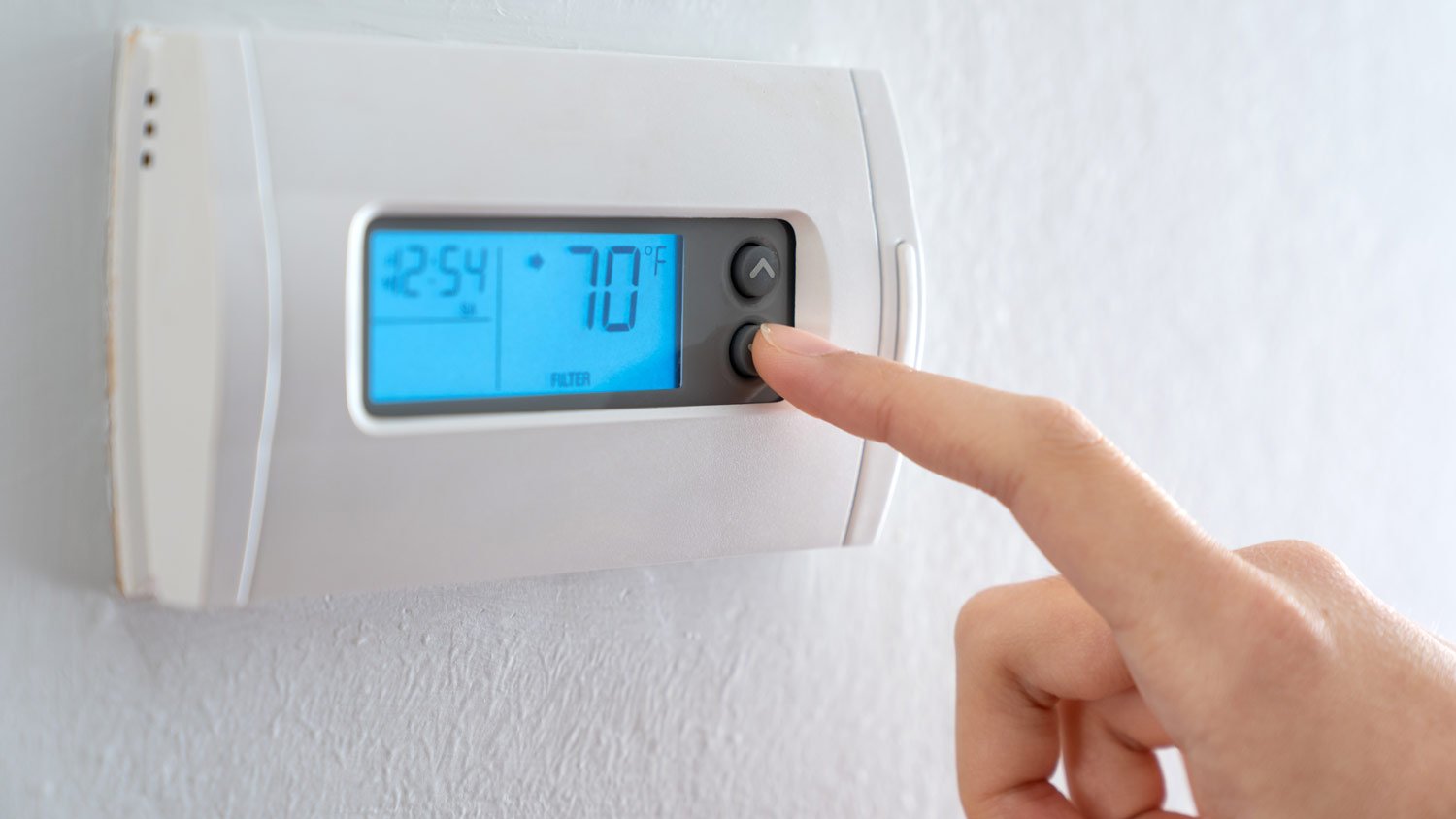
What you’ll pay in Columbus, OH, for furnace repairs depends on many factors. Here’s a breakdown of what can go wrong and the cost to fix those issues.
Beat the heat and banish the chill with a trusty thermostat


Thermostats control the temperature in your home using sensors or bimetallic strips to switch heating or cooling on or off.
Thermostats can be digital or mechanical and cost $100 to $300 to install.
Regular cleaning and maintenance will help your thermostat work more efficiently and extend its life span.
When you want to warm up your home on the first chilly day of winter or start lowering the temperature when sweltering summer temperatures hit, the first thing you do is head to your thermostat. You may not think much about this device or how it works until it isn’t functioning properly. So, how does a thermostat work, and how do you know when it needs some TLC? Let’s explore your home thermostat from the inside out.
A thermostat is a device that connects to your home’s heating and cooling systems to control the set temperature in a room or throughout the home. You can find a thermostat for an entire HVAC system or on an individual unit, like a window air conditioner.
A thermostat has controls, ranging from simple buttons on a manual thermostat to app controls on your phone for smart thermostats, that allow you to adjust the temperature or program temperature changes for the future. The entire goal of the thermostat is to make your home have a comfortable room temperature, no matter the weather outside.
Depending on the type of thermostat, there are a few different ways it can detect a temperature and send signals to the heating or cooling system to kick on. Electronic thermostats use sensors to detect temperature. When the temperature in the room doesn’t match the temperature a user has set on the thermostat’s control buttons, the thermostat can signal to the heating or cooling unit to turn on and start dispersing warm or cool air.
Mechanical thermostats use bimetallic coils or strips, which expand or contract. These coils or strips connect to the thermostat’s circuit card, so as they expand or contract, they will switch the heating or cooling on through the circuit card.
There are two main types of thermostats: digital and mechanical. Digital thermostats include programmable thermostats and smart thermostats, both of which can help save energy costs compared to mechanical versions. However, mechanical models tend to be simpler to use and install and come at a lower upfront cost.
Digital thermostats, or electrical thermostats, include programmable and smart varieties. Both options can help reduce energy use by adjusting temperature settings, but smart thermostats offer greater energy savings. However, smart thermostats tend to be one of the more expensive thermostat options out there.
Programmable thermostats have controls that allow homeowners to set temperature changes for the future. For instance, if you know you prefer to sleep in a colder room, you can program the thermostat to lower the temperature every night starting at 9 p.m. That way, the room is just the right temperature when you’re ready for bed. You can also save energy with a programmable thermostat by adjusting the settings to change the temperature slightly over the course of each day rather than running full-blast every day.
Smart thermostats work by using sensors to detect air temperature and energy usage. They send signals to a microcontroller inside the system to adjust the temperature, for instance, to set the best AC temp for energy savings. These thermostats are unique in that they connect to smart home devices, like speakers and smartphones, so that you can control the thermostat with a few taps on your phone or via your voice. They can also “learn” your heating and cooling habits over time and adjust the temperature to suit your preferences.
Mechanical thermostats, or manual thermostats, may be considered more old-school, and they aren’t as flashy or functional as smart or even programmable thermostats. But where they lack in bells and whistles, mechanical thermostats shine when it comes to user-friendliness and longevity.
When it comes to thermostat life spans, manual models tend to last the longest—35 years on average. Smart and programmable thermostats last 10 years on average. Mechanical thermostats cost less than their electrical counterparts, as well.
One thing to note, of course, is that mechanical thermostats aren’t as accurate as digital versions. This can also mean that they use more energy to try to meet the set temperature. And as far as temperature settings go, mechanical thermostats offer minimal functionality. You can’t program them for future temperature changes. When you start feeling too warm or too cold, you’ll need to go to the thermostat and change the settings as needed.

Installing a thermostat costs $100 to $300, depending on the model. Smart thermostats are the most expensive option upfront, costing $130 to $300 on average. Some smart thermostats can cost over $1,000 if a pro is installing them in a larger home or more complex HVAC system. The trade-off is that smart thermostats can save you around 8% of heating and cooling costs per year, according to Energy Star.
Programmable thermostats cost $20 to $150, while manual thermostats are the least expensive option, costing $15 to $35.
Sometimes, installing or replacing a thermostat is easy for homeowners, especially if you opt for a battery-powered and wireless version. But this is a challenging home improvement project that is not as straightforward as it seems.
Smart thermostats need a common wire, or C-wire, to work properly, and some thermostats may need to be wired to your heating and cooling system in order to control the temperature. If installing a new thermostat of any kind will involve wires, you should hire a local thermostat installer to get this device up and running for you.
It’s best to leave any type of thermostat installation to the pros because mistakes can be costly. If the thermostat isn’t installed correctly, it can lead to high energy bills and quicker wear and tear of important HVAC components.

How do you know when it’s time to repair a thermostat or replace it with something new? With today’s smart thermostats, outdated technology can be a simple sign that it’s time to upgrade to a modern version. But with mechanical models that can last a few decades, it’s not as easy to tell when to replace it.
Some signs that it’s better to replace your thermostat include:
Your energy bills are high
Your heating or cooling system is running frequently
Your heating or cooling system isn’t running often enough
Temperatures fluctuate in a room or throughout the house
The thermostat is over 10 years old for digital models
The thermostat is over 30 years old for mechanical models
The thermostat won’t turn on, even with new batteries
To get the most out of your thermostat (and keep it running smoothly), a little maintenance goes a long way. First, cleaning the thermostat at least twice per year can keep it in good condition. To clean the thermostat, use a clean, dry cloth for the exterior. For the interior, you can use a small, soft brush or even compressed air to clear away dust and dirt that builds up. Change the thermostat batteries at least once per year. Batteries help ensure the thermostat stays on even if there’s a power disruption.
You should also hire an HVAC technician to perform a professional inspection at least once per year. The pros will take a look at the thermostat for any signs of trouble, like corroded or loose wires, and make repairs as needed.
From average costs to expert advice, get all the answers you need to get your job done.

What you’ll pay in Columbus, OH, for furnace repairs depends on many factors. Here’s a breakdown of what can go wrong and the cost to fix those issues.

Whole-house humidifier costs vary based on the type and size of the unit, along with other factors. The price might be worth it for people living in dry regions.

Getting AC and furnace replacement done at the same time can lead to huge benefits for your wallet and your home. Here’s everything you need to know.

Discover the average wall heater installation cost, key price factors, and expert tips to help you budget and save on your next home heating project.

There are few things more important to homeowners than keeping their AC systems running. Use this guide on AC leak repair to keep your home cool and comfy.

Ductwork losing energy? Here are six duct sealing methods that will help you get some big savings on your monthly energy bills.